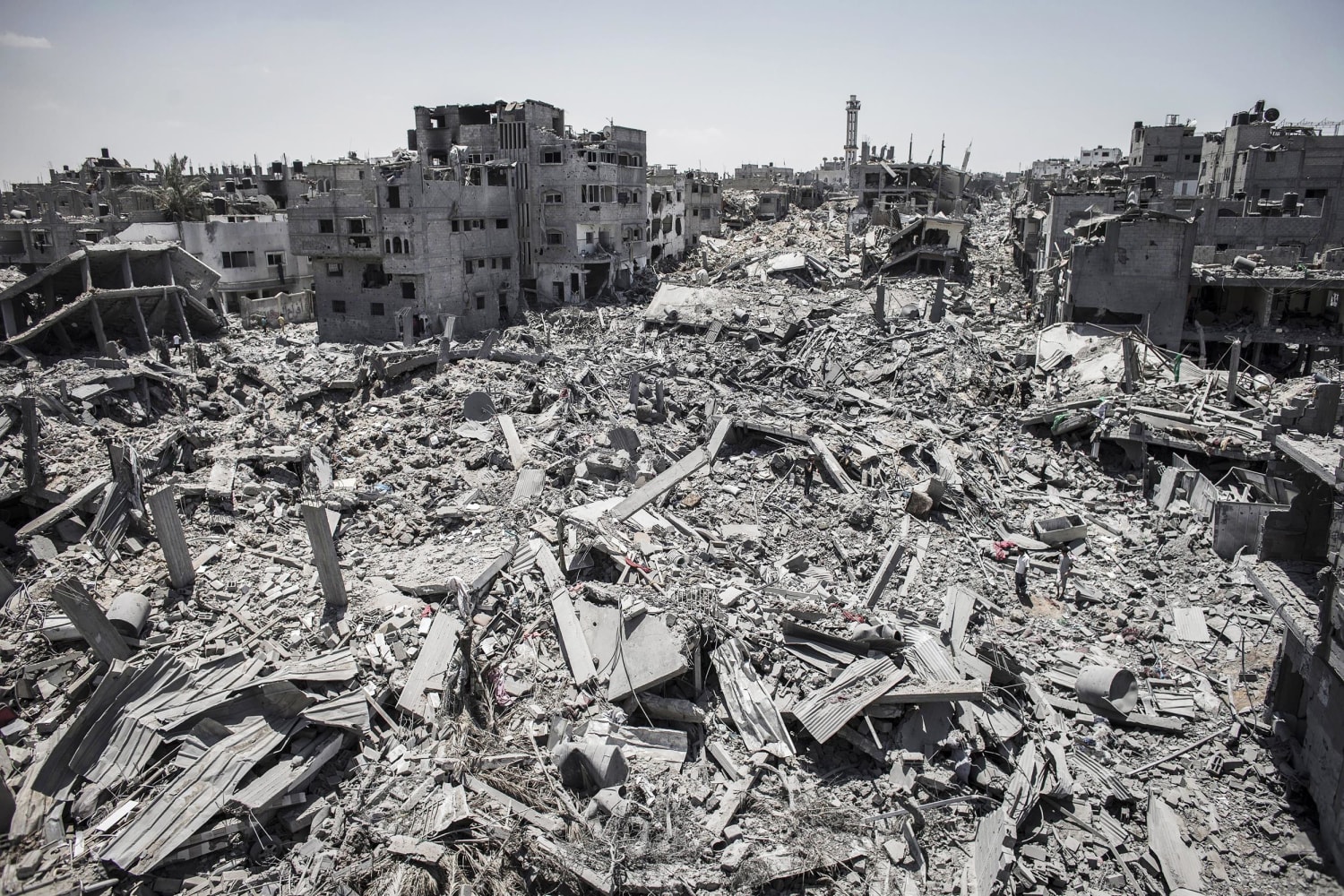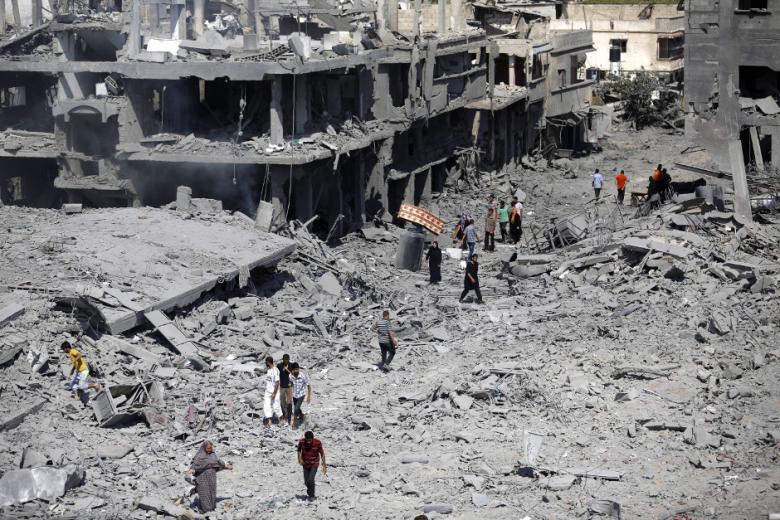
"Is Israel The World's Worst Terror State?
An Israeli General's Son Thinks So"
An Israeli General's Son Thinks So"
"Frog Hospital" And "Pax On Both Houses" Discuss "Netanyahu And Obama's Deal With Iran"
IDF playing war games, but with real Palestinians
The Israeli army used a training maneuver in the West Bank this week to prepare for potential unrest in the territories. Haaretz accompanied the soldiers, and witnessed a surreal exercise.
GOC Central Command Maj. Gen. Nitzan Alon concluded nearly a decade in the West Bank this week. He had served in the territories since 2005, apart from a two-year break in which he established the intelligence operations division. Alon was commander of the territorial brigade in the Bethlehem region, chief of the Judea and Samaria Division, and GOC. On Wednesday, Maj. Gen. Roni Numa took over the key role. Alon will become head of the Israel Defense Forces’ Operations Directorate in two months. Even if he doesn’t say so, it’s a safe bet he won’t miss his old job.
Alon came to the West Bank toward the end of the second intifada, after the death of Palestinian leader Yasser Arafat. At the time, the Palestinian leadership reached the conclusion that the use of terrorism had been unproductive politically, considering that Israel’s response to the wave of deadly attacks had effectively brought about the collapse of the Palestinian Authority in the West Bank and exacted a fearsome price from the population.
In the 10 years since then, the PA has consolidated anew its hold in the cities of the West Bank, largely restored law and order in the areas under its control, ignited economic growth and established highly effective security coordination with Israel.
Hamas remains popular in the territories, though the failure of Israeli pollsters with their recent election exit poll predictions suggests we should be equally cautious about polls conducted in the West Bank.
What is not in doubt is that the number of terror attacks has greatly decreased. Contrary to various worrisome predictions, the wholesale return of Hamas activists to the West Bank and the Gaza Strip from Israeli prisons – following the Gilad Shalit prisoner-exchange deal in October 2011 – has so far not sparked a new uprising in the territories.
The Hamas networks in the West Bank are currently receiving guidelines and funds from the organization’s headquarters in Istanbul and Gaza. The IDF and the Shin Bet security service believe Hamas cells continue to exist in the West Bank, whether dormant or active, though with lower operational capability than when the wave of terror attacks was at its height.
Though the IDF has warned at various junctures in the past decade that a third intifada could erupt, this has not come to pass. On three occasions – 2008, 2012 and 2014, in the wake of Israel’s respective military operations in the Gaza Strip – mass confrontations with the IDF broke out in the West Bank. However, the PA’s security forces intervened and restored stability, notwithstanding shooting incidents and Palestinian fatalities.
Terrorism erupted sporadically, usually perpetrated by lone individuals with no organizational infrastructure behind them. The most serious attacks took place in Jerusalem last fall, in the wake of the summer war in Gaza and tensions on the Temple Mount.
The surge of terrorism abated when the police and the Shin Bet imposed a security clampdown in Jerusalem, and, in particular, after Prime Minister Benjamin Netanyahu finally instructed the extremists within his coalition to desist from provocative visits to the Temple Mount. At present, the urban intifada in Jerusalem appears to have petered out.
A growing problem
A new eruption of violence could be triggered by a local incident of a religious character (involving the Temple Mount again, or a serious attack by Jewish extremists on a West Bank mosque); exacerbation of the political crisis between Israel and the PA; an economic crunch in the West Bank; or a combination of all of the above.
Israel has discerned growing difficulty on the part of Palestinian President Mahmoud Abbas – who celebrated his 80th birthday yesterday – to control the Tanzim (the Fatah movement’s grassroots groups). Tanzim activists are bearing arms more openly than in the past, and challenging the PA’s authority in the refugee camps. Israeli Police Commissioner Yohanan Danino said recently, in a private forum, that the defense establishment is concerned about a possible renewal of terrorist activity by the Tanzim – a phenomenon that disappeared in the past decade.
The IDF set the end of March as the target date for completing its preparations, ahead of a possible new eruption of violence in the West Bank. The confrontation could come later, or not happen at all at present, as the Palestinians focus their efforts on the international diplomatic arena.
The three terms that are most in use in internal IDF briefings are containment; restraint in the use of force; and avoidance of large-scale Palestinian casualties. But even such well-intentioned planning does not take into account the fact that it is the blue – Israeli – side that is initiating in the confrontation against the adversary, which is marked in red on the briefing maps.
The current danger of possible escalation is attributable to the actions of both sides: the Palestinians’ request, last December, to join the International Criminal Court in The Hague; Israel’s subsequent decision to freeze the transfer of 1.5 billion shekels ($380 million) of tax revenues collected for the Palestinians; and Likud’s victory in the election last week, which has aggravated the sense of pessimism in the territories.
The military effort to prepare an effective but not exaggerated response is akin to the promise of the Waze navigation application to bring a driver to his destination by the quickest possible route. What happens is that, as the app directs more and more drivers using Waze to that same quick route, it causes it to become jammed – which is to say, the behavior of the system itself wields considerable influence on the course of events and the final results.
Dress rehearsal under coercion
This week, during a visit to nighttime maneuvers by the IDF’s Territorial Brigade in the Ramallah (Binyamin) region, in preparation for a possible escalation on the ground, one could discern an effort by the commanding officers to delineate for the troops the character of the expected confrontation.
Only the brigade commander and, to a lesser degree, the battalion commanders still remember what a genuine West Bank intifada looks like. The company commanders may have fought in Gaza, but not in the West Bank. The exercise was predicated on a mix of possible events: violent mass demonstrations; shooting attacks; and use of live fire by members of the Palestinian security forces.
In practice, the sector was quiet. As the soldiers advanced on foot toward the town of Bir Zeit, next to Ramallah, the antennae of the new Palestinian city of Rawabi were visible behind them, to the north. Late last month, after multiple bureaucratic delays, Israel finally agreed to allow the city to be connected to the water-supply infrastructure. IDF officers say they are impressed by the high level of construction in the meticulously planned city, which will eventually house some 40,000 Palestinians. A four-room apartment will cost $120,000. It’s 45 minutes (and one checkpoint) by car from Tel Aviv, but at this stage Israeli investors aren’t showing an interest.
The Israeli forces raid Bir Zeit at points chosen in advance. The soldiers climb up a hill to the town through groves and fields, and then spread out on the empty streets. In one house, a drowsy male student in pajamas – a Jenin resident studying at Bir Zeit University – converses in English with a female soldier from a Home Front Command battalion. A superficial search turns up a poster in memory of the two East Jerusalem terrorists who murdered four worshipers and a policeman at a Jerusalem synagogue last November.
In the Home Front battalions, which carry out missions in the territories very similar to those of the infantry (policing, routine security, arrest of Palestinian suspects), women are full-fledged combatants, executing the same tasks as the men in mixed units. What no one on the Israeli side seems to be taking into consideration is that by sending women out on night missions into the homes of a society that remains quite conservative, Israel is sticking another finger in the eye of the Palestinians.
The exercise was planned with the goal of causing relatively little disruption to the routine of Palestinian life. The only complaint that reached the Israeli media came from the head of the regional council in the (Jewish) Beit Arye settlement: his PR man fired off an angry email about an attack helicopter landing in the settlement without prior warning. The helicopter, he wrote, “woke up children and caused panic among the inhabitants.” The army apologized and explained that the helicopter was supposed to have landed next to a nearby Palestinian village.
Still, after almost 48 years of occupation, it seems that only an outsider is taken aback by situations the IDF blithely accepts. It’s the duty of commanders to collect intelligence and prepare their troops ahead of a possible confrontation. However, within the framework of the maneuvers – and with no immediate security need – the Palestinian residents become extras who are not asked whether they want to take part in the dress rehearsal, and receive no warning of what is about to take place. Their homes are targets for night visits, searches and the family’s coerced awakening.
At best, the PA can preserve order and protect the citizens of the West Bank from manifestations of anarchy. But when the IDF enters, the PA steps aside and the inhabitants are left on their own. Shortly before the exercise began, the Israeli brigade commander phoned his Palestinian counterpart to inform him about the planned entry of the troops. According to the regular procedure, which is also applied in real operations to arrest suspects, the Palestinian commanders ordered police officers to remain inside the camps and police stations.
The first stage of the exercise ended at 3 A.M., the dark hour when prime ministers fear phone calls bearing bad news. The brigade’s units had completed the task of locating the targets.
The rest of the night also passed without any unusual drama. The events reported via radio communication – firebombs being thrown, sniper fire, an attempted suicide bombing attack – didn’t go beyond the scenarios invented by the leaders of the exercise. Bir Zeit would soon awaken to a new day.
Today and every day, about 160,000 Palestinians from the West Bank – some 40,000 of them illegally – make their living from working in Israel, the settlements and Israeli industrial zones in the West Bank. These are the same people, of course, who are theoretically carrying out acts of terror in the aforementioned scenarios. The Israeli security forces recently issued 10,000 new work permits, in an effort to offset the economic damage being caused by the freeze on tax transfers. Besides, someone has to go on building the settlements.

No comments:
Post a Comment